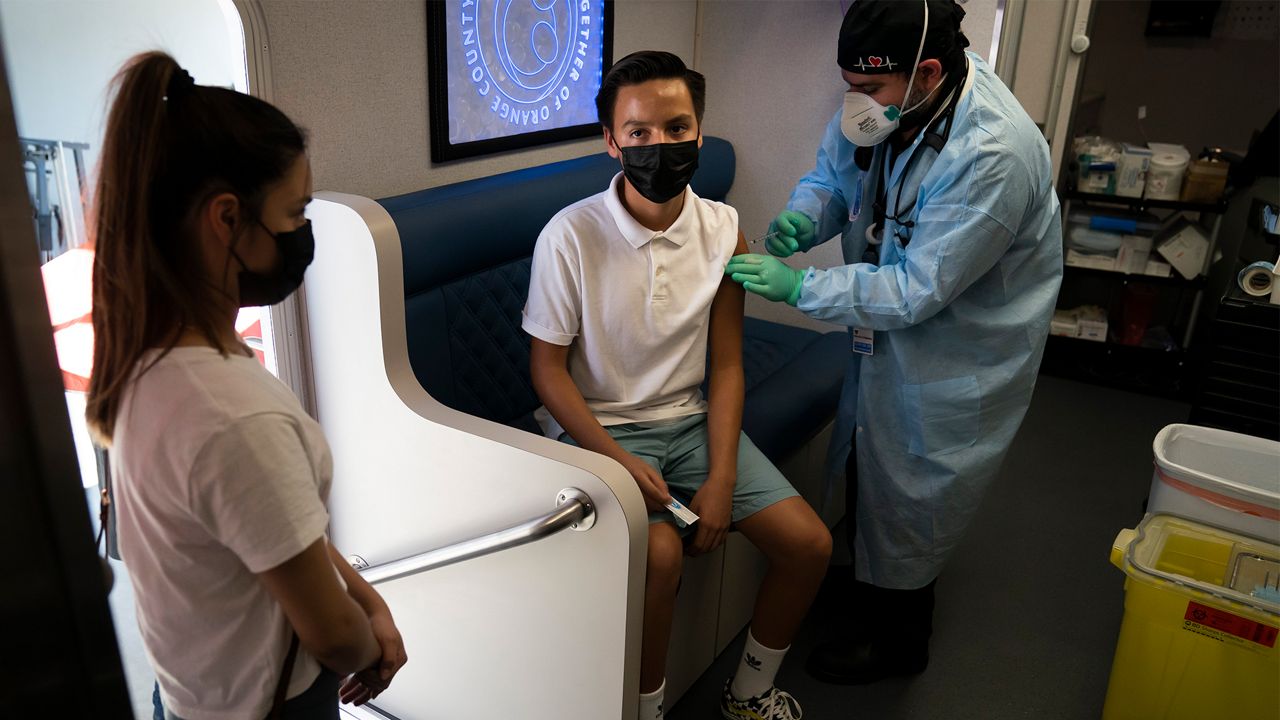SANTA ANA, Calif. (CNS) — Orange County saw a significant jump in COVID-19 hospitalizations Friday and fatalities this month also continued to climb with five more deaths logged, including two in the 25-to-34 age range.
Experts says deaths should skew toward the younger ages, because the vaccination rate is so high among the county's seniors.
Four of the fatalities logged on Friday occurred this month, the most recent one happening Aug. 18 and two more on Aug. 17. One of the deaths occurred at the end of last month. The overall death toll stands at 5,202.
Vaccinations have steeply driven down the death toll each month since records were set in December and January, but it now appears they are trending back up due to the more contagious Delta variant.
One of the deaths logged Thursday was in the 25-to-34 age group, and two more were added on Friday, according to the Orange County Health Care Agency. The total in that age group for the entire pandemic stands at 62.
Three deaths "is not a trend," but there shouldn't be any rise in fatalities now that vaccines are available, said Andrew Noymer, an epidemiologist and UC Irvine professor of population health and disease prevention, told City News Service.
"There will be fewer deaths than this winter, so we should be happy, but if you think about it, there should be none. The vaccines work," he said Friday.
Dr. Clayton Chau, the county's chief health officer and director of the Orange County Health Care Agency, agreed, telling reporters on Friday that "any deaths are unfortunate, because we have options."
Chau said the surge of deaths from the Delta variant will not match the fatality rate during the winter.
"Yes, the number is nothing compared to the last surge and winter time, but people don't have to die if they just get the vaccine," Chau said. "We will see more younger people who are in the hospital and more younger people who die from Covid because we've done a very good job of vaccinating seniors. We're way over 90% (of those) over 65 who have received at least one dose and over 80% are fully vaccinated."
Chau also said hospitalized COVID-19 patients are "generally in their mid 30s to mid 40s."
Three fully vaccinated residents infected with COVID-19 died in recent days, but they were all immonocompromised, and one of them had "multiple health conditions," Chau said.
Despite the increase in fatalities, the monthly death toll is notably lower than during the spring.
"The July and August deaths are still quite modest," Noymer said.
The death toll for August is now 27, higher than July's 17. This marks the first time since the winter surge that there has been a month-to-month increase in fatalities.
The death toll for June is 15; 23 for May; 44 for April; 199 for March; 615 for February; 1,574 for January — the deadliest month of the pandemic — and 969 for December, the next-deadliest.
Hospitalizations, which Noymer flags as the most important coronavirus statistic, jumped up from 565 on Thursday to 592 on Friday, with the number of intensive care unit patients rising from 122 to 132.
Up until Friday's bump up, hospitalizations were steady this week.
"Hospital numbers are back up," Noymer said. "I hate to say I told you so ... We're going to hope it goes back down again. The testing percentages are not that bad so that's maybe a feather in our cap, but the hospital numbers are up again."
Noymer noted that last Friday there were 571 patients hospitalized, "so we've gone up by 20. How do you get a jump of 30 more patients? And the ICU is keeping pace. Monday is going to be huge."
By Monday, officials say they will get a sense if students returning to classes have contributed to a new wave of infections.
Chau said he had his weekly call with superintendents on Friday.
"They've noticed more cases of kids who come to school and get infected from outside of school," he said.
Chau said there has been a "drop in cases from 19- to 24-year-olds," but added, "I am bracing myself — and hopefully it won't happen — but I have a suspicion we'll see a rise in cases of children."
The OCHCA released updated vaccination numbers on Thursday, showing a number approaching 2 million residents inoculated.
The county has 1,989,131 fully vaccinated residents. That includes 1,857,185 who received the two-dose Moderna or Pfizer vaccines and 131,946 who received the one-dose Johnson & Johnson shot.
The case rate per 100,000 residents as of Aug. 21 was 35.9 for unvaccinated residents, but 6.5 for the fully vaccinated.
According to weekly averages released on Tuesdays, the county's average daily case rate per 100,000 residents increased from 20.2 to 22.2, while the test positivity rate ticked down from 8.1% to 8%.
The county's Health Equity Quartile rate, which measures the impact on disadvantaged communities, remained at 8.4%.
Another 930 infections were reported Friday, raising the cumulative total to 283,573 since the pandemic began.
The county had 20.2% of its adult ICU beds and 69% of its ventilators available.
Health experts note that many of the infections being logged are due to an increase in testing and many are among vaccinated residents so the symptoms are not leading to serious illness requiring hospitalization. Some are being caught as patients are admitted to hospitals for unrelated reasons.



